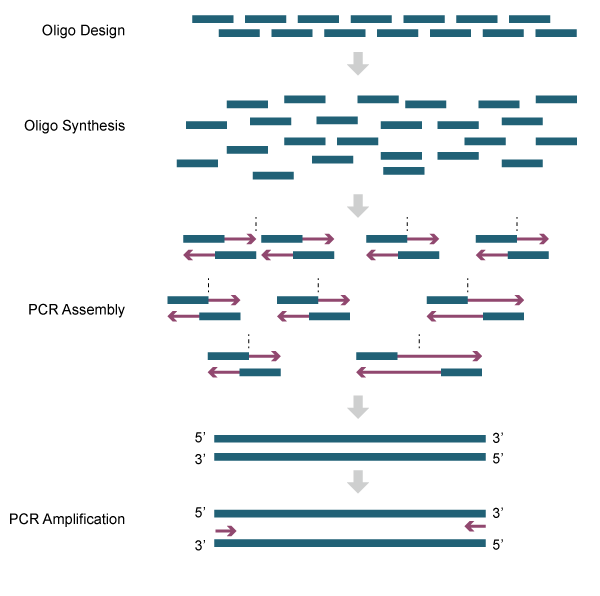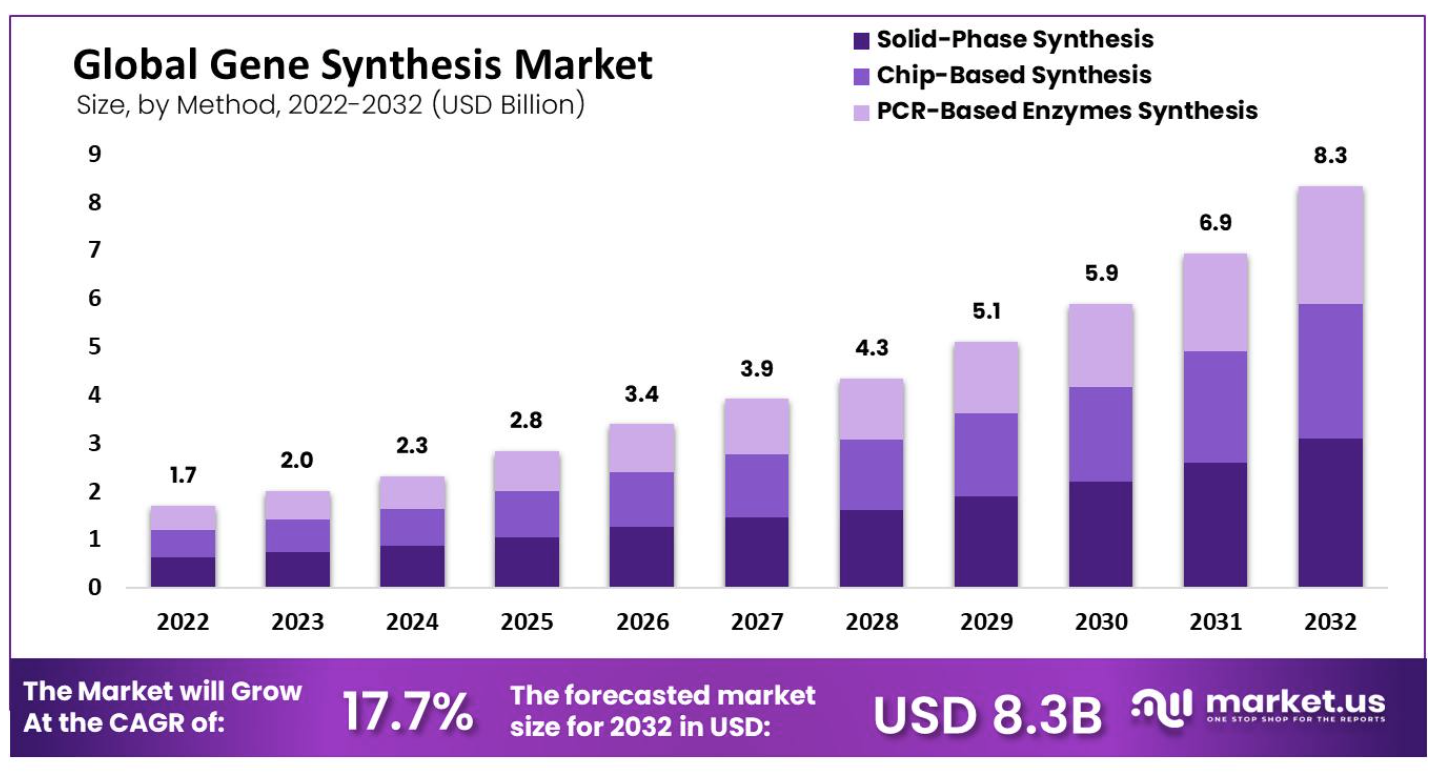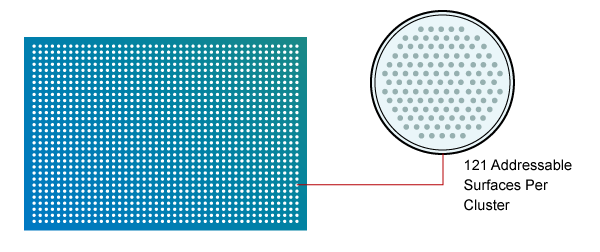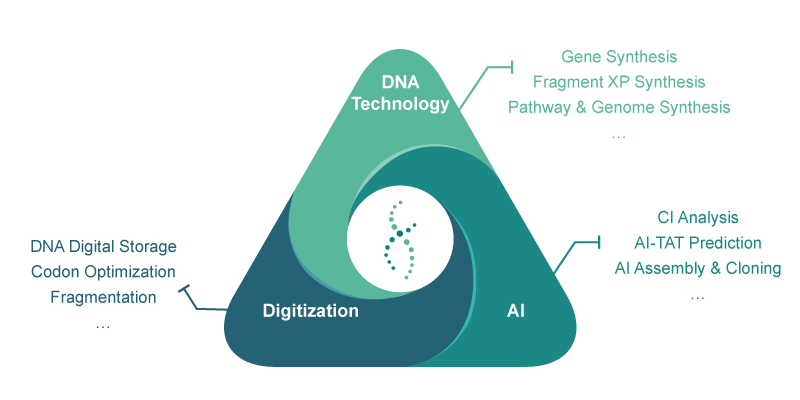The Rise of Commercial Gene Synthesis
As life science research continues to deepen and biotechnological applications become increasingly widespread, the demand for gene synthesis has expanded from basic scientific research to broader commercial applications. Initially, gene synthesis primarily served basic research, such as validating theoretical hypotheses and constructing genetic models. However, with the rapid development of industries such as pharmaceuticals, agriculture, and industrial biotechnology, the demand for custom gene sequences has surged. This shift in demand is reflected not only in quantity but also in higher requirements for synthesis speed, accuracy, and cost-effectiveness.
In the pharmaceutical sector, the development of new drugs requires the rapid synthesis of a large number of different gene sequences for drug target screening and drug development. In agriculture, the cultivation of genetically modified crops with desirable traits also relies on efficient gene synthesis technology. In the field of synthetic biology, low-cost gene synthesis can significantly accelerate scientific innovation, reduce biotechnological development costs, and promote the development and commercialization of products in food, cosmetics, energy, and chemical industries. This growing and evolving demand has driven the rapid rise of the commercial gene synthesis industry, providing a vast market space for the development of innovative companies.
Standardization in Commercial Gene Synthesis
• Early Commercial Gene Synthesis
Early gene synthesis was primarily based on the step-by-step assembly method using PCR. Short oligonucleotide fragments were chemically synthesized and enzymatically assembled in the correct order to construct complete gene sequences.

Step-by-step Assembly of PCR
• Advantages and Disadvantages
▶ Precise synthesis of target gene sequences, mature technical processes, and guaranteed synthesis success rates.
▶ Low synthesis efficiency, complex and time-consuming operations, and high costs, which limit large-scale applications.
• Representative Company: Gene Art
Gene Art, a pioneer in commercial gene synthesis, standardized operational processes and quality control systems, making it a crucial bridge between research needs and professional gene synthesis services. Its standardized processes and quality control systems became industry benchmarks, and its successful business model provided a reference for later entrants, driving the industry's rapid development.
Market-Driven High-Throughput Gene Synthesis
• Market Demand
In 2025, the global gene synthesis market is estimated to be valued at USD 2.8 billion and is projected to reach $8.3 billion by 2032 (a compound annual growth rate of 17.7%). As life science research enters the omics era and the biotechnology industry scales up, the market demands higher throughput in gene synthesis. Traditional gene synthesis technologies cannot meet the need for synthesizing large numbers of different genes simultaneously. For example, drug screening requires testing thousands of different gene variants for drug responses, and synthetic biology requires constructing complex biological systems with numerous functional genes. Driven by these market demands, high-throughput gene synthesis technology has emerged.

Image Source: Market.US, "Gene Synthesis Market," 2023
• High-Throughput Gene Synthesis
High-throughput gene synthesis (HTGS) is a technology that enables the simultaneous, large-scale synthesis of numerous different gene sequences. Compared to traditional gene synthesis methods (solid-phase synthesis), HTGS is based on chip technology and employs automated, highly parallel processes to synthesize thousands or even tens of thousands of gene sequences in a short time, providing robust support for large-scale genetic engineering research.

Chip-based High-throughput Synthesis
• Advantages and Disadvantages
▶ High synthesis throughput, low cost, and high flexibility.
▶ Accuracy in synthesizing complex sequences needs improvement.
• Representative Company: Twist Bioscience
Twist Bioscience focuses on high-throughput gene synthesis solutions. It has broken through the throughput limitations of traditional gene synthesis, driving the industry toward high-throughput, low-cost gene synthesis services, and introducing new business models and development opportunities.
AI-Powered Gene Synthesis
• Limitations of Existing Technologies
Despite significant breakthroughs in throughput and cost, high-throughput gene synthesis technology still faces higher challenges due to diverse market demands.
1. Efficiency in synthesizing ultra-long gene sequences is limited.
2. Error rates are high for complex sequences (e.g., high GC content, repetitive sequences).
3. It is difficult to precisely optimize functional requirements during the gene design phase.
• AI-Powered Gene Synthesis
Artificial intelligence algorithms are used to deeply analyze and optimize gene sequences, significantly improving synthesis efficiency and accuracy. AI technology can predict and resolve potential issues in complex sequences and provide precise gene sequence optimization during the design phase, ensuring that synthesized sequences fully meet functional requirements. This technology is applicable to diverse needs, from basic research to industrial applications, including gene construction, gene editing, and high-throughput library construction.
• Advantages and Disadvantages
▶ Intelligent design improves the success rate of complex sequence synthesis.
▶ AI technology is still in development, and algorithms require continuous optimization.
• Representative Company: Synbio Technologies
Synbio Technologies is committed to becoming a leader in synthetic biology empowerment. As the first company to introduce AI technology into gene synthesis, it aims to solve high-difficulty, complex gene synthesis challenges by providing intelligent and precise gene synthesis solutions.
Self-developed Bio-intelligent Analysis Tools
-
Complex Index (CI): Solves synthesis challenges for difficult sequences (repetitive sequences, hairpin structures, high GC content).
-
NG Codon: Codon optimization design to improve protein expression efficiency.
-
AI-TAT: Accurately predicts production cycles, helping customers plan subsequent experiments.

AI-Powered Gene Synthesis
• Industry Contribution
Synbio Technologies has introduced AI technology into gene synthesis, bringing new ideas and solutions to the industry. It has driven the transition of gene synthesis technology from experience-driven to data-driven and intelligence-driven approaches, injecting new vitality into the industry's technological upgrade and innovation.
Opportunities and Challenges for Commercial Gene Synthesis
• In Vivo Synthesis
As commercial gene synthesis continues to evolve, the industry is poised for a new transformation— In Vivo Synthesis. In vivo synthesis involves using living cells (e.g., bacteria, yeast, or mammalian cells) as "factories" to synthesize target genes directly within the organism by regulating gene expression and metabolic pathways. This method leverages the cell's natural biosynthetic mechanisms—such as DNA replication, transcription, and translation—to efficiently and accurately synthesize complex gene sequences.
• Advantages of In VivoSynthesis
1. Efficiency: Cells can perform multiple synthesis reactions simultaneously, making it suitable for large-scale production.
2. Precision: Natural error-correction mechanisms (e.g., DNA repair systems) reduce synthesis errors.
3. Environmental Friendliness: Utilizes natural metabolic pathways, reducing chemical waste.
4. Versatility: Enables simultaneous gene synthesis, expression, and functional validation.
• Future Challenges
1. Metabolic Interference: Other metabolic pathways within the cell may interfere with target gene synthesis.
2. Regulation Complexity: Precise regulation of gene expression and metabolic pathways is required to avoid overburdening the cell.
3. Scalability Bottlenecks: Large-scale cell culture and gene expression optimization still require technological breakthroughs.
In the future, with advancements in synthetic biology, gene editing, and related fields,in vivo synthesis is expected to become a mainstream direction, bringing revolutionary changes to the gene synthesis industry.
 DNA Synthesis
DNA Synthesis Vector Selection
Vector Selection Molecular Biology
Molecular Biology Oligo Synthesis
Oligo Synthesis RNA Synthesis
RNA Synthesis Variant Libraries
Variant Libraries Genome KO Library
Genome KO Library Oligo Pools
Oligo Pools Virus Packaging
Virus Packaging Gene Editing
Gene Editing Protein Expression
Protein Expression Antibody Services
Antibody Services Peptide Services
Peptide Services DNA Data Storage
DNA Data Storage Standard Oligo
Standard Oligo Standard Genome KO Libraries
Standard Genome KO Libraries Standard Genome Editing Plasmid
Standard Genome Editing Plasmid ProXpress
ProXpress Protein Products
Protein Products
























